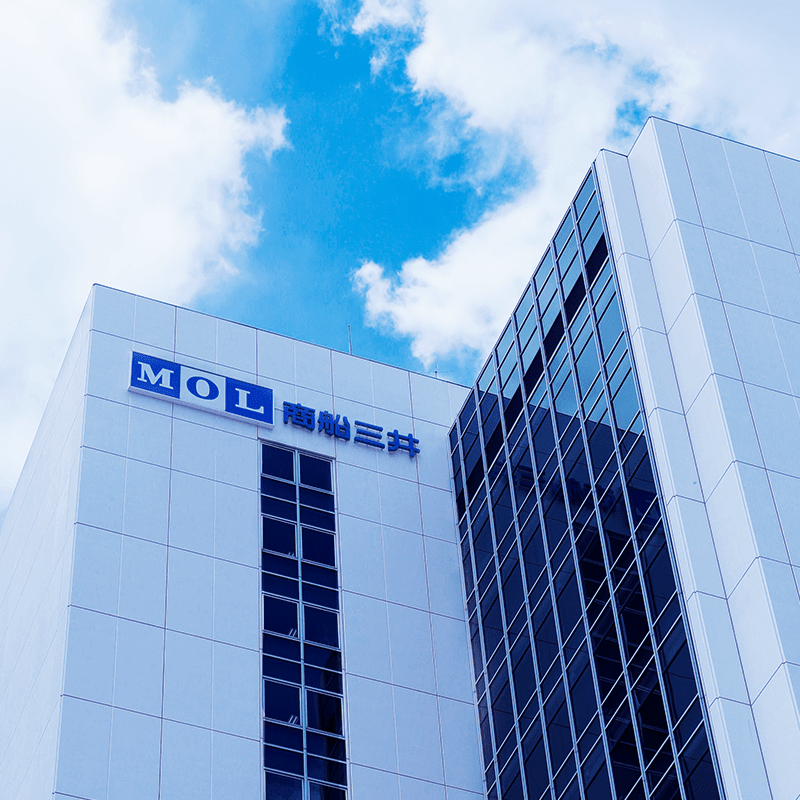BLOG
What Is Carbon Dioxide Removal (CDR)? MOL Explains — Making Sense of Reduction and Removal
- Eco Friendly
- General Shipping
2025.08.04
As global warming becomes an increasingly urgent issue, the concept of not only reducing carbon dioxide (CO₂) emissions but also removing existing CO₂ from the atmosphere is gaining attention. This "removal" approach is considered an essential element for achieving the long-term goal of the Paris Agreement: “to pursue efforts to limit the global temperature increase to below 1.5°C above pre-industrial levels. “This blog explains the differences between "reduction" and "removal," and introduces MOL’s carbon dioxide removal business, which actively engages in various methods for Carbon Dioxide Removal (CDR) to realize a carbon-neutral society.
.jpg?width=573&height=274&name=Global%20greenhouse%20gas%20emissions_WEF%20CDR%20Best%20Practice%20Guideline%20(1).jpg)
Global Greenhouse Gas Emissions (Billion Tons-CO₂e/year)(Source: World Economic Forum, ‟CDR Best Practices Guidelines,” 2023)
Key Points
- Mitsui O.S.K. Lines (MOL) pursues carbon neutrality through both reduction and removal strategies.
- CDR (Carbon Dioxide Removal) is categorized into nature-based, tech-based, and hybrid approaches.
- MOL engages in nature-based CDR through mangrove restoration and forest fund investments overseas.
- DAC and DOC innovations are driving the social implementation of tech-based CDR.
- MOL aims to remove 2.2 million tons of CO₂ by 2030, accelerating efforts toward a decarbonized society.
Reduction and Removal: Two pronged approach for achieving Carbon Neutrality
To begin with , let’s take a look at the basic difference between "reduction" and "removal".
Reduction
Reduction refers to reducing the amount of carbon dioxide (CO₂) newly emitted into the atmosphere as a result of activities such as burning fossil fuels. For example, replacing fossil fuels with renewable energy sources. Even when fossil fuels are used, capturing the CO₂ they generate and storing it underground in a way that prevents it from being released back into the atmosphere over the long term can also be regarded as a CO₂ reduction.
Removal
Removal refers to the process of capturing CO₂ that already exists in the atmosphere and storing it in a way that ensures long-term sequestration, effectively decreasing the total amount of CO₂ in the air. To achieve the net-zero goal by 2050 and the 1.5°C target of the Paris Agreement, it is essential not only to reduce emissions as much as possible but also to remove any residual emissions already released into the atmosphere.
In other words, since it is difficult to completely eliminate emissions, both "reduction" and "removal" are indispensable for achieving net-zero.
Various Approaches: Main Methods of CDR
There are various methods for removing CO₂ from the atmosphere, broadly categorized into three types: Nature-based, Technology-based, and Hybrid.
.jpg?width=751&height=369&name=Nature%20based_Hybrid_Tech-based%20CDR%20(1).jpg)
(Source: Prepared by MOL based on Swiss Re, ‟2020 SONAR Report”)
Nature-based CDR
Nature-based CDR refers to approaches that leverage natural ecosystems to directly remove CO₂ from the atmosphere. Specific examples include:
- Afforestation and Reforestation:
Trees absorb CO₂ through photosynthesis during their growth and sequester carbon. Projects such as The Reforestation Fund targeting Latin America and mangrove restoration and conservation in Indonesia, funded by MOL, fall into this category.
- Soil Carbon Sequestration:
By improving land management practices on farmland and forests, it is possible to increase the amount of carbon stored in the soil.
- Others:
Seagrass and seaweed also absorb CO₂ through photosynthesis, so the conservation and restoration of blue carbon ecosystems in the ocean are included.
Technology-based CDR
Technology-based CDR refers to industrial methods that use technological processes to capture directly from the atmosphere and storage CO₂ permanently. Examples include:
- Bioenergy with Carbon Capture and storage (BECCS):
Capturing CO₂ emitted when biomass is burned and storing it underground.
- Direct Air Capture (DAC):
Air is drawn in using large fans, and specialized sorbents are used to extract CO₂ directly from the atmosphere. The captured CO₂ is then stored underground for over 1,000 years. Heirloom, a company backed by MOL, is one example utilizing this technology.
- Direct Ocean Capture (DOC):
This method uses electrochemical processes to separate and capture dissolved CO₂ directly from seawater, which is then stored underground for over 1,000 years. Captura, another company supported by MOL, employs this method.
Hybrid CDR
Hybrid CDR refers to approaches that artificially enhance natural carbon cycle process to improve CO₂ removal efficiency.
- Enhanced Rock Weathering :
Accelerating the natural process where rocks react with rainwater to capture CO₂ in the soil. Minerals in the rocks react with carbon dioxide in rainwater to form bicarbonate ions, capturing and stabilizing the carbon dioxide.
- Biochar:
Biomass is pyrolyzed in the absence of oxygen to produce a carbon-rich material called biochar. When used as a soil amendment or building material, it sequesters carbon permanently.
- Ocean Alkalinization :
Adding alkaline substances to seawater to promote natural carbon absorption in the ocean.
MOL's Carbon Credit Business: Contribution to a Decarbonized Society
MOL has set a goal of achieving net-zero emissions by 2050 as part of its ‟ MOL Group Environmental Vision 2.2” and considers CDR a key component of its strategy. The company has voluntarily set a milestone to contribute to the removal of 2.2 million tonnes of CO₂ by 2030 and is actively working to promote and expand CDR efforts.
Specific initiatives include:
- Mangrove Restoration/Conservation Project in Indonesia (Nature-based):
MOL aims to reduce, absorb, and sequester 11 million tons of CO₂ emissions over 30 years through mangrove restoration and conservation activities in South Sumatra.
.jpg?width=768&height=576&name=%E3%83%9E%E3%83%B3%E3%82%B0%E3%83%AD%E3%83%BC%E3%83%96%20(1).jpg)
(A photo taken on location by our Carbon Removal Team)
- Investment in the Reforestation Fund I, LP (Nature-based):
MOL has invested US$25 million to this fund focused on reforestation and afforestation in Latin America. The project also contributes to biodiversity and local community development.
Establishment of a joint venture company ‟Marubeni MOL Forests Co., Ltd.” with Marubeni Corporation (Nature-based):
This JV focuses on the creation, sale, and retirement of Nature-based CDR credits, contributing to both climate action and sustainable development.
Collaboration with Kansai Electric Power Co., Inc. in the carbon credit business (Nature-based and Technology-based):
The two companies are collaborating on nature-based and technology-based removal credit projects in Africa and Southeast Asia.
Participation in the joint purchase scheme NextGen for CDR credits (Technology-based):
MOL has joined NextGen, a joint CDR credits procurement scheme led by Mitsubishi Corporation and South Pole, to accelerate the deployment of high-integrity, tech-based CDR solutions.
.jpg?width=751&height=373&name=Next%20Gen%20CDR%20Facility%20(3).jpg)
NextGen CDR Facility
Investment in Heirloom, a company developing DAC technology in the United States (Technology-based):
MOL has invested in Heirloom through MOL Switch, a 100% subsidiary of MOL Group, contributing to the improvement of DAC technology and promoting the spread and expansion of CDR in society.
%20(1).jpg?width=643&height=262&name=Heirloom%20DAC%20technology%20(1)%20(1).jpg) (Source: Company Press Release)
(Source: Company Press Release)
Signing a large-scale credit purchase agreement derived from DOC with Captura, a company developing DOC technology in the United States (Technology-based):
MOL signed a Memorandum of Understanding for a partnership to purchase CO₂ removal credits created by DOC and developing DOC business. In conjunction with this MOU, MOL also invested in Captura through MOL Switch.
%20(1).jpg?width=800&height=408&name=How%20our%20Direct%20Ocean%20Capture%20system%20works%20(1)%20(1).jpg)
(Source: Company Press Release)
MOL is advancing CO₂ removal through strategic and diverse approaches in collaboration with various organizations both domestically and internationally to achieve its goals. The company plans to strengthen efforts beyond the shipping sector and make proactive investments, enhancing partnerships with companies across different industries and exploring joint projects. We will continue to announce new initiatives going forward.
Promoting the Development and Social Implementation of Various CDR Technologies
Achieving carbon neutrality requires efforts from both a "reduction" and "removal". CDR plays a crucial role in accelerating climate action by actively removing CO₂ already present in the atmosphere. Companies and organizations, including MOL, are leveraging their unique strengths to promote the development and social implementation of diverse CDR solutions. As we watch future progress closely, each of us must consider what we can do to contribute to the future of our planet.
.jpg?width=311&height=415&name=Mr.%20hirose%20(1).jpg)
(Carbon Removal Team Leader / Hirose)
Recommended Articles
2022.07.05
- General Shipping
2021.04.13
- Energy
2023.12.19
- General Shipping
2021.08.07
- Eco Friendly
2025.03.18
- General Shipping
Latest Articles
2025.12.09
- Eco Friendly
- General Shipping
2025.12.03
- General Shipping
2025.11.20
- Energy
- General Shipping
- BLOG
- What Is Carbon Dioxide Removal (CDR)? MOL Explains — Making Sense of Reduction and Removal








